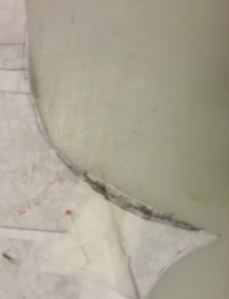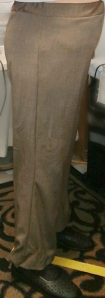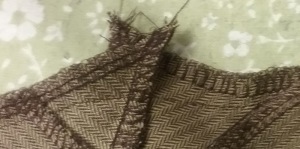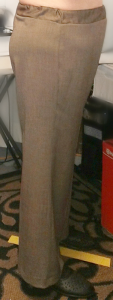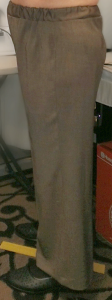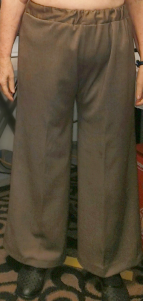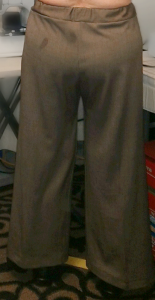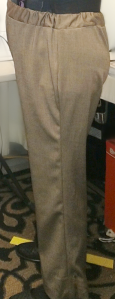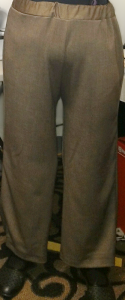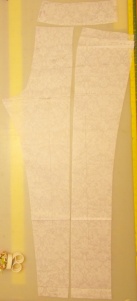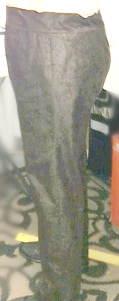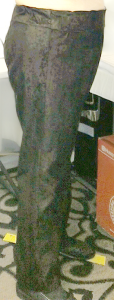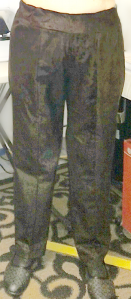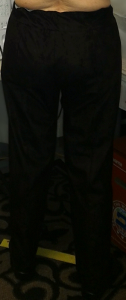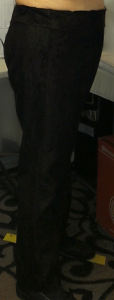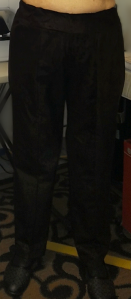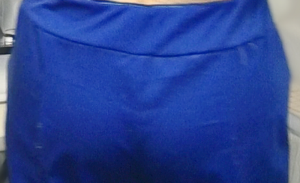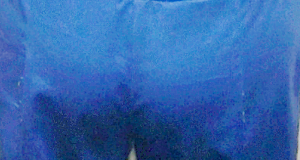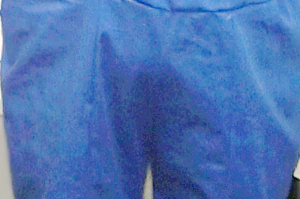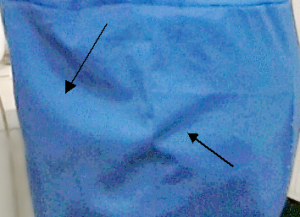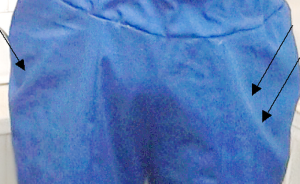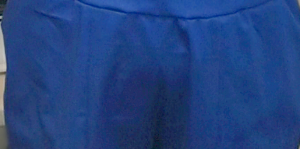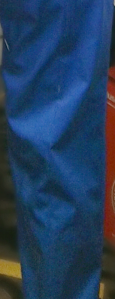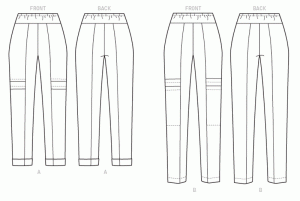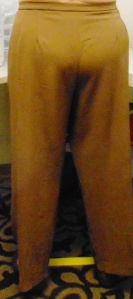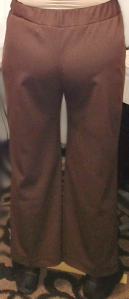When I’m having problems, I find that it really does help when I stop; put aside my project and turn my attention elsewhere. Yesterday, I put everything away neatly and went upstairs dinner and a Christmas movie. It’s that time of year. In the morning, I knew what to do.
I ripped out the crotch, again. Pulled one leg in the other and pinned the crotches together ready for recutting. Then I pulled out the final tissue for 6461 to compare with 3414 1A. If you haven’t rad Morgan’s post at SG, I truly recommend you do so, especially if you are having problems fitting pants. Morgan gives a list of things to check when your pants don’t fit. It’s not the normal or most familiar list. At the end Morgan says, if none of the above work, probably the crotch shape does not match your own. (This is not an exact quote therefore not in quote marks.) So in the morning I said “Hmm. How can I check that easily?” Hence, I pulled out 6461 and compared with 3414.
The 3414 1A front crotch extension was just slightly longer (and of course the inseam curve just a bit different). That was what I wanted. I felt that 6461 could stand just a little more length, I was thinking 1/8″ on both front and back.
The back crotch was also a little longer but more importantly there is this distinctive scoop (colored with a black Sharpie for clarification). The curve actually starts changing up by the hip line, swoops down at least 1/4″ deeper than 3414 1A, then bends back up and terminates at the 1/4″ back inseam. Huh! Could that make enough difference?
So not entirely convinced I’d discovered the error and tired of unserging, I serge finished the crotch and the inseams so that can be easily ripped apart again. I’ve got enough fabric left over to make a big, really big, like waist-to-knee gusset. If that’s what it takes. After trimming the back crotch to the new crotch shape, I stitched crotch and inseams with water-soluble thread. I also restitched the side seams, with WST, after pinning them several places. I was hoping to remove the drag lines that suddenly appeared when I took the side seams in another inch. I have the hems at 22″ now but I’d rather have 18-20″. I like the 24″ hems for certain fabrics, certain occasions. Did I mention walking along the beach; wind blowing through my hair; tugging my pant legs? Ah… back to SD in the winter… I basted the inseams removing another 1/2″ at the inseam. Thereby reducing the hem circumference to 21″. Little more than I prefer, but much improved over 24. Then of course it was “Take A Picture Alexa.”
Once again, my right-side pant-leg hangs pretty nice. I’d say beautifully but I’m sure someone will take exception and point out some bumps and drag lines below the knee. Sigh, the left side
Not so good. Nearly the same set of drag lines as the previous. I would hate to wear these pants looking like that.
OK so I didn’t get these pulled up evenly at the waist. It’s one of the things I dislike about elastic waist pants. Any VPL is justified today and also I have a camisole tucked in. Fortunately I wear my tops long enough to cover this. Always. More concerned about the drag lines forming around the knee and not sure if that is fitting or fabric. One of the reasons I prefer the 18-20″ hem is that it hangs better. Has less of a tendency to develop these kind of drag lines. You know, it’s just too bad that Advertising has done so much air brushing that we expect to wear pants that have no hint of a fabric fold, at all. Bottom line, I like the front.
Looking at the back
There is some improvement over the first photo. I have not pressed well since before cutting the fabric. The WST likes to disappear when I hit it with steam so I put off pressing until I’m pretty sure I’ve made all my changes. It’s just that I’m wondering if that would be a benefit. But I have to admit, the back is still pulling towards the front, just not as much as when I started this party. I think it is definitely time for a different gusset and more length on the extensions. Oh, BTW, the last change to the back crotch created a barely peaked intersection.
So what became the final fit, I extended the crotches the old recommended way i.e. slice down and rotate out, spreading both front and back crotch points 1/2″. I’ve added a total of 1″ length under there (stride) plus whatever little may have been added when the back crotch was scooped. I cut a couple of big rectangles from my left overs and set aside. Then I sliced off the crotches of the pant-in-construction. Lined up the rectangles with the newly trimmed crotches; and serged rectangles to crotch. Pressed the seam just created and started an unexpectedly difficult aligning of the back crotch pieces and then front crotch pieces. Oh my. They really didn’t want to cooperate. I finally got the fronts cut and started the same wrestling match on the back crotches. One of my rectangles was not as wide as the other. So when I placed the tissue on top for cutting, I had a shorter side. A side not big enough for the entire crotch length. At this point I’d already mentally decided I wasn’t applying another gusset to this pair of pants. I have more fabric, but the pant crotches have had it. I thought of cutting off the too short gusset but felt like the crotch just wouldn’t take the extra handling. So I trimmed off that gusset and added yet another piece carefully aligned with the fabric stripe. Now I cut a gusset of sufficient length.
Following on the thought that these pants weren’t going to make it through another gusset application, I serged back and front inseams together; serge finished crotch edges and then stitched the long inseams together. To my horror, the pants developed an even bigger point in the crotch that ever before. To smooth the curve out, because I can’t wear something like that, I stitch straight across the point.
I measured. I removed an inch in length. I removed equal to what I have added during the 3 sewing/fitting sessions of 1A! Now totally assured that this pant is done and likely not to fit, I finished all the seams. Removed the WST and stitched with thread at the original sewing line i.e. even though I have been trying to narrow the pant leg, I stitched it at the full 24″. I had not managed to make the left side seam look any nicer then it did to begin with. In my mind, no use in sewing it that way, let’s go back to where that seam was nice. I also removed the 1/2″ very nice seams that I made 1/2″ in at the inseam. I hemmed with hardly any care but did lightly starch and carefully press, not sparing the steam. “Alexa, Take a pic.”
Both side seams look exceptionally nice, again.
Actually the front doesn’t look too bad. The left side is rather good except for the fold that develops along the side of my leg. Not sure if I should be concerned about that. After all, a drapey fabric will follow the body beneath. My front waist is pulled again to the right side somehow. I don’t understand this. I quartered the elastic; quartered the waistband. The elastic is stitched on the facing side and aligned with the quarter marks. It shouldn’t move around. Yet, it wants to pull left. I’m not exactly sure what to do but it may not matter if the back is as bad as expected.
… and then the back, totally surprised me. This is not terrible. It’s not even bad. I thought with that awful gusset and having actually cut off the length added, it would be uglier than sin. These things are WEARABLE. Holy cow, I need to quit now and do something else.

